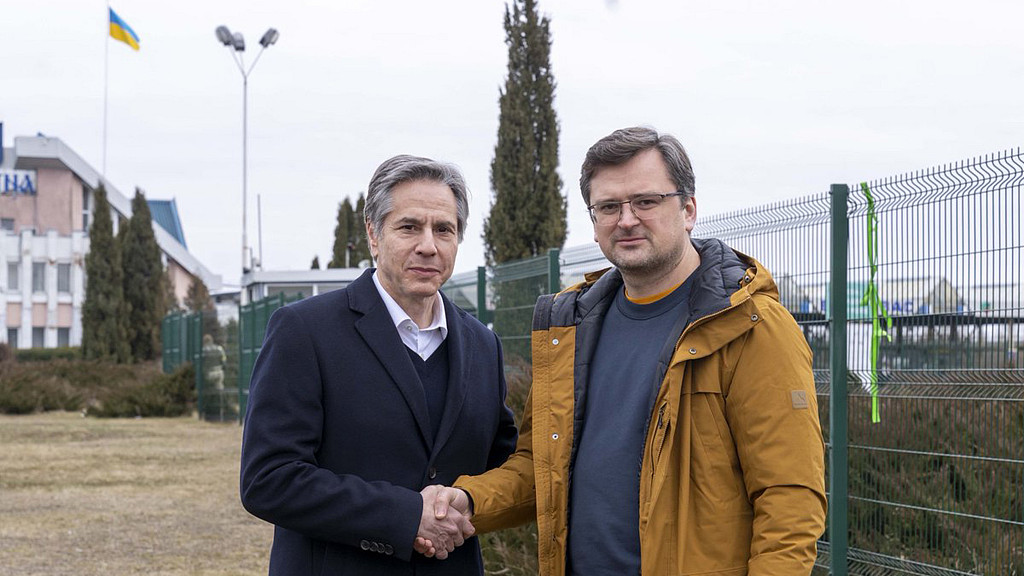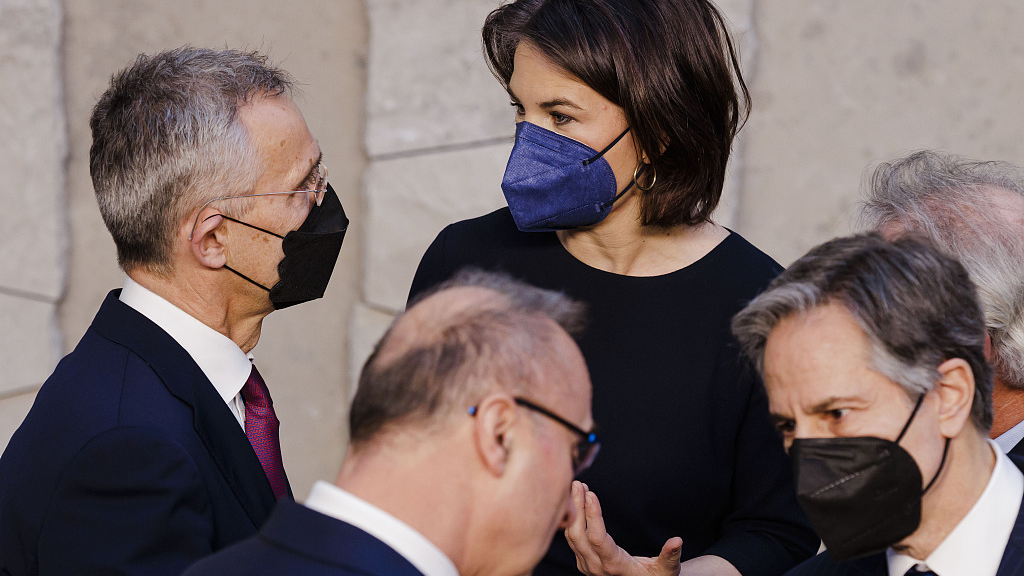
U.S. Secretary of State Antony Blinken (left) and Ukrainian Foreign Minister Dmytro Kuleba meet at the Ukrainian-Polish border crossing, March 5, 2022. /VCG
U.S. Secretary of State Antony Blinken (left) and Ukrainian Foreign Minister Dmytro Kuleba meet at the Ukrainian-Polish border crossing, March 5, 2022. /VCG
Editor's note: Andrew Korybko is a Moscow-based American political analyst. The article reflects the author's views and not necessarily those of CGTN.
Ukrainian negotiator David Arakhamia announced over the weekend that his country is open to "non-NATO models" for ensuring its security while maintaining that it'll never compromise on its territorial integrity. He suggested that "for example, there could be direct guarantees by different countries like the U.S., China, UK, maybe Germany and France. We are open to discussing such things in a broader circle, not only in bilateral discussions with Russia but also with other partners."
While observers might welcome this idea as a positive step in the direction of reaching a compromise on Russia's request that Ukraine never joins the U.S.-led anti-Russian military bloc, everything might not be exactly as it seems at first glance. Arakhamia's mentioning of NATO members might rile Russia since it could be interpreted as those countries pursuing the de facto extension of the bloc's Article 5 to Ukraine, which refers to the organization's collective security commitments.
It shouldn't be forgotten that Russian President Vladimir Putin revealed during his speech on February 24 that NATO had allegedly established clandestine military infrastructure in Ukraine ahead of what he warned was a planned surprise attack against his country. He implied that it could follow the attempted U.S. neutralization of Russia's nuclear second-strike capabilities through the continued regional deployment of "anti-missile systems" and strike weapons near its borders.
While NATO and Ukraine denied these Russian claims, they've both been very upfront about the bloc's dispatch of Javelin anti-tank missiles and other forms of military equipment. Joint military exercises have also taken place on the territory of that former Soviet Republic over the years. Their ties are very close, on the surface, which makes one wonder how much deeper they go beneath it. They're not formal allies, but their relations are definitely of a very privileged and strategic nature.

NATO foreign ministers and other officials meet at NATO headquarters in Brussels, Belgium, March 4, 2022. /VCG
NATO foreign ministers and other officials meet at NATO headquarters in Brussels, Belgium, March 4, 2022. /VCG
Russia's ongoing special military operation in Ukraine aims to accomplish three strategic tasks apart from its immediate one of stopping Kyiv's attacks against the indigenous Russian people of Donbas. These are that country's denazification, demilitarization, and neutrality. Russia regards the ultra-nationalist forces that rose to power with U.S. support after the Western-backed "EuroMaidan" color revolution coup of 2013-2014 to be Nazis, though Ukraine and its partners reject this description.
That former Soviet Republic accelerated its militarization with full Western assistance following the loss of Crimea that spring and the subsequent conflict in Eastern Ukraine's Donbas region. Russia regarded this and other U.S. regional moves as earlier described to be gross violations of the Organization for Security and Cooperation in Europe's (OSCE) principle of indivisible security whereby no party or group thereof is allowed to advance their security at anyone else's expense.
This explains one of the reasons why it wants Ukraine to remove its constitutionally enshrined goal of joining NATO that was approved by the bloc during its 2008 Bucharest Summit. Moscow has legitimate security interests stemming from what international relations experts call the "security dilemma." This concept refers to one party's suspicions of the other's self-proclaimed defensive moves like what the Kremlin claims the U.S., NATO, and Ukraine have done vis-a-vis its national security red lines.
Russia's openly stated desire to revise the European security architecture in such a way that the OSCE's principles are finally implemented can be described as the overarching motivation behind its diplomatic and military moves as of late. Since events in and around Ukraine triggered Moscow's special military operation there, that former Soviet republic will inevitably be part of the larger solution between Russia and NATO, though it might likely take time to materialize in light of recent events worsening relations.
Knowing what's been publicly revealed by Russian officials concerning their country's threat perception of the U.S., NATO, and the military moves by those two in and around Ukraine, it's unlikely that the Kremlin will accept any informal extension of this anti-Russian alliance's Article 5 over that former Soviet republic. This essentially dooms that aspect of Arakhamia's proposal, but the concept of "non-NATO models" is still promising insofar as Ukraine and its partners decide to fulfill the OSCE's principles.
That hasn't hitherto happened despite Russian diplomats actively trying to encourage them to do so since they published their security guarantee requests in late December, but it still remains the most viable political solution for sustainably ensuring indivisible security in Europe. No serious progress on this front is expected barring unforeseen developments, of which there have been many over the past month, but, hopefully, all parties will agree on the need to rely on the OSCE for guidance.
(If you want to contribute and have specific expertise, please contact us at opinions@cgtn.com. Follow @thouse_opinions on Twitter to discover the latest commentaries in the CGTN Opinion Section.)

